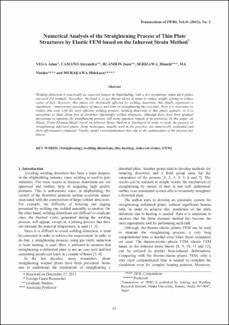Mostrar el registro sencillo del ítem
Numerical analysis of the straightening process of thin plate structures by elastic FEM based on the inherent strain method
| dc.contributor.author | Vega, Adán | |
| dc.contributor.author | Camaño, Alexandra | |
| dc.contributor.author | Blandón, Juan | |
| dc.contributor.author | Serizawa, Hisashi | |
| dc.contributor.author | Hidekazu Murakawa, Ninshu Ma | |
| dc.date.accessioned | 2017-08-23T17:10:12Z | |
| dc.date.accessioned | 2017-08-23T17:10:12Z | |
| dc.date.available | 2017-08-23T17:10:12Z | |
| dc.date.available | 2017-08-23T17:10:12Z | |
| dc.date.issued | 2012-12 | |
| dc.date.issued | 2012-12 | |
| dc.identifier.uri | http://ridda2.utp.ac.pa/handle/123456789/2867 | |
| dc.identifier.uri | http://ridda2.utp.ac.pa/handle/123456789/2867 | |
| dc.description | Welding distortion is practically an expected feature in shipbuilding, with a few exceptions; when thick plates are used, for example. Nowadays, the trend is to use thinner plates in order to reduce weight, aiming to reduce waste of fuel. However, thin plates are drastically affected by welding distortion, this finally represents a significant - unnecessary expenditure of money and time on straightening the structure. Here it is necessary to realize that even with the most effective welding process, welding distortion in thin plates appears, so it is unrealistic to think about free of distortion lightweight welded structures. Although there have been gradual movements to optimize the straightening process, still many question remain to be answered. In this paper, an Elastic Finite Element Model based on Inherent Strain Method is developed in order to study the process of straightening deformed plates. Some techniques, usually used in the practice, are numerically evaluated and their effectiveness compared. Finally, useful recommendations that aim to the optimization of the process are drawn. | en_US |
| dc.description.abstract | Welding distortion is practically an expected feature in shipbuilding, with a few exceptions; when thick plates are used, for example. Nowadays, the trend is to use thinner plates in order to reduce weight, aiming to reduce waste of fuel. However, thin plates are drastically affected by welding distortion, this finally represents a significant - unnecessary expenditure of money and time on straightening the structure. Here it is necessary to realize that even with the most effective welding process, welding distortion in thin plates appears, so it is unrealistic to think about free of distortion lightweight welded structures. Although there have been gradual movements to optimize the straightening process, still many question remain to be answered. In this paper, an Elastic Finite Element Model based on Inherent Strain Method is developed in order to study the process of straightening deformed plates. Some techniques, usually used in the practice, are numerically evaluated and their effectiveness compared. Finally, useful recommendations that aim to the optimization of the process are drawn. | en_US |
| dc.language | eng | |
| dc.language.iso | eng | en_US |
| dc.rights | https://creativecommons.org/licenses/by-nc-sa/4.0/ | |
| dc.rights | info:eu-repo/semantics/openAccess | |
| dc.subject | straightening | en_US |
| dc.subject | welding distortion | en_US |
| dc.subject | line heating | en_US |
| dc.subject | inherent strain | en_US |
| dc.subject | FEM | en_US |
| dc.subject | straightening | |
| dc.subject | welding distortion | |
| dc.subject | line heating | |
| dc.subject | inherent strain | |
| dc.subject | FEM | |
| dc.title | Numerical analysis of the straightening process of thin plate structures by elastic FEM based on the inherent strain method | en_US |
| dc.type | info:eu-repo/semantics/article | |
| dc.type | info:eu-repo/semantics/publishedVersion |
